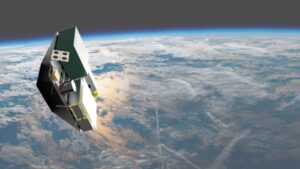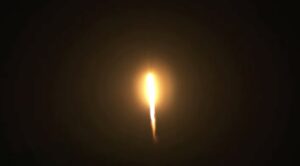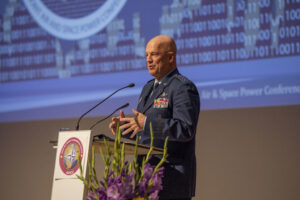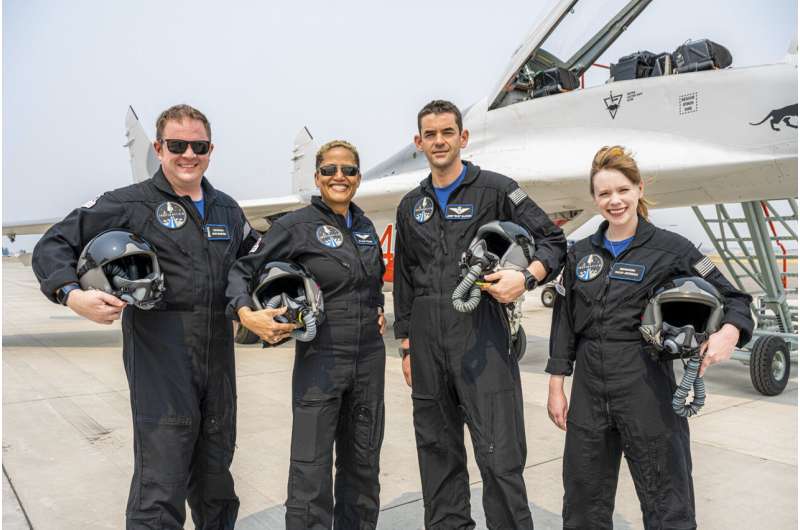New Navy task force to work on bringing unmanned systems into operations
Tuesday, 14 September 2021 11:33 The U.S. Navy has set up its first-ever task force that'll use a vast ocean area in the Middle East as the setting for learning how to incorporate unmanned systems and artificial intelligence into maritime operations.
Task Force 59 will specifically be focused on the U.S. 5th Fleet area of operations, the Navy said on Thursday.
The fleet was selected for its strategic importance,
The U.S. Navy has set up its first-ever task force that'll use a vast ocean area in the Middle East as the setting for learning how to incorporate unmanned systems and artificial intelligence into maritime operations.
Task Force 59 will specifically be focused on the U.S. 5th Fleet area of operations, the Navy said on Thursday.
The fleet was selected for its strategic importance, AFRL promotes 'one lab, two services' at Space Symposium
Tuesday, 14 September 2021 11:33 Air Force Research Laboratory Commander Maj. Gen. Heather Pringle and other AFRL subject matter experts gathered to connect with the space community at the Space Foundation's 36th National Space Symposium in Colorado Springs August 23-27.
Space Foundation Chief Executive Officer, retired U.S. Navy Rear Admiral Thomas E. Zelibor opened the annual symposium, which was last hosted in April 20
Air Force Research Laboratory Commander Maj. Gen. Heather Pringle and other AFRL subject matter experts gathered to connect with the space community at the Space Foundation's 36th National Space Symposium in Colorado Springs August 23-27.
Space Foundation Chief Executive Officer, retired U.S. Navy Rear Admiral Thomas E. Zelibor opened the annual symposium, which was last hosted in April 20 SPY-7 Hybrid Defense program with Japan completes additional capability tests
Tuesday, 14 September 2021 11:33 On August 26, the Missile Defense Agency (MDA) and U.S. Navy Aegis Technical Representative (TECHREP) witnessed a successful Mid-Release 2 Demonstration of the software release for the Japanese J7.B Aegis Weapon System equipped with SPY-7 radar, in Moorestown, New Jersey. Japan will field J7.B onboard an afloat Aegis System-Equipped Vessel (ASEV) to provide ballistic missile defense (BMD).
On August 26, the Missile Defense Agency (MDA) and U.S. Navy Aegis Technical Representative (TECHREP) witnessed a successful Mid-Release 2 Demonstration of the software release for the Japanese J7.B Aegis Weapon System equipped with SPY-7 radar, in Moorestown, New Jersey. Japan will field J7.B onboard an afloat Aegis System-Equipped Vessel (ASEV) to provide ballistic missile defense (BMD). SpaceX launches Starlink satellites into orbit from West Coast
Tuesday, 14 September 2021 11:33 Elon Musk's SpaceX successfully launched a stack of Starlink satellites into space Monday night, the first such launch since May.
The Falcon 9 rocket lifted off through a cloud of fog on schedule at 8:55 p.m. PDT from Space Launch Complex 4E at the Vandenberg Space Force Base in California, carrying 51 Starlink satellites into space, which were deployed about 30 minutes later.
SpaceX
Elon Musk's SpaceX successfully launched a stack of Starlink satellites into space Monday night, the first such launch since May.
The Falcon 9 rocket lifted off through a cloud of fog on schedule at 8:55 p.m. PDT from Space Launch Complex 4E at the Vandenberg Space Force Base in California, carrying 51 Starlink satellites into space, which were deployed about 30 minutes later.
SpaceX Planet provides data to federal civilian agencies under NASA contract
Tuesday, 14 September 2021 11:00
Researchers delving into climate change, biodiversity loss and other topics through work funded by U.S. federal civilian agencies and the National Science Foundation will have access to Planet Earth-observation data through September 2022, under a NASA contract announced Sept.
There's now a gas station in space
Tuesday, 14 September 2021 10:29
According to the Union of Concerned Scientists (UCS), over 4,000 operational satellites are currently in orbit around Earth. According to some estimates, this number is expected to reach as high as 100,000 by the end of this decade, including telecommunication, internet, research, navigation, and Earth Observation satellites. As part of the commercialization of low Earth orbit (LEO) anticipated in this century, the presence of so many satellites will create new opportunities, as well as hazards.
The presence of these satellites will require a great deal of mitigation to prevent collisions, servicing and maintenance. For example, the San Francisco-based startup Orbit Fab is working to create all the necessary technology for orbital refueling services for satellites. To help realize this goal, industry giant Lockheed Martin recently announced that they are investing in Orbit Fab's "Gas Stations in Space" refueling technology.
The San Francisco-based startup was founded in 2018 by Daniel Faber and Jeremy Schiel, both of whom have strong backgrounds in the commercial space industry. Between 2016 and 2019, Faber was the CEO of Deep Space Industries (DSI), one of the leading companies currently developing asteroid mining capabilities.
Virtual ESA Open Day registration now open
Tuesday, 14 September 2021 10:15
Registration for this year's virtual ESA Open Day is now open. This tenth annual ESA Open Day will take place on Sunday 3 October.
ESA Open Day registration now open
Tuesday, 14 September 2021 10:15
Registration for this year's ESA Open Day is now open. This tenth annual ESA Open Day will combine an in-person visit of ESA's ESTEC technical centre in the Netherlands by people with disabilities (and their carers as needed) on Saturday 2 October and a virtual event for everyone, taking place on the following day, on Sunday 3 October.
BAE Systems to acquire smallsat company In-Space Missions
Tuesday, 14 September 2021 09:45
BAE Systems announced Sept. 14 that it will acquire In-Space Missions, a company that recently won a contract to build a British military satellite.
Announcing Earth observation hackathon winners
Tuesday, 14 September 2021 07:00
In June 2021, more than 4300 participants from 132 countries and territories came together to solve challenges related to the COVID-19 pandemic. ESA, NASA and the Japan Aerospace Exploration Agency (JAXA) are pleased to announce CleverChart and TRACER as the winners of the Open Science Award.
SpaceX launches first dedicated polar Starlink mission
Tuesday, 14 September 2021 03:58
SpaceX launched its first dedicated polar Starlink mission Sept. 13 as the company moves into the next phase of deployment of its broadband satellite constellation.
Raymond: Small satellites and fast data transforming space business
Monday, 13 September 2021 19:29
The combination of small satellites and computing power is one of the most exciting developments in space technology, said Gen. John "Jay" Raymond, chief of the U.S. Space Force
Marlink’s sale values maritime connectivity specialist at $1.4 billion
Monday, 13 September 2021 19:05
Private equity firm Providence Equity Partners has agreed to buy a majority stake in Marlink, valuing the maritime connectivity specialist at $1.4 billion.
SpaceX’s Starlink broadband to be available in Japan’s remote areas next year
Monday, 13 September 2021 18:18
SpaceX’s Starlink satellite broadband service will be available in Japan’s remote areas starting in 2022.
EXPLAINER: 4 will circle Earth on 1st SpaceX private flight
Monday, 13 September 2021 18:10
For the first time in 60 years of human spaceflight, a rocket is poised to blast into orbit with no professional astronauts on board, only four tourists.
SpaceX's first private flight will be led by a 38-year-old entrepreneur who's bankrolling the entire trip. He's taking two sweepstakes winners with him on the three-day, round-the-world trip, along with a health care worker who survived childhood cancer.

